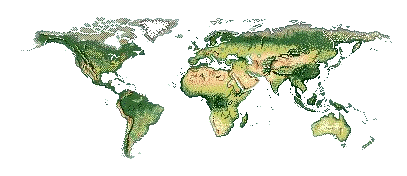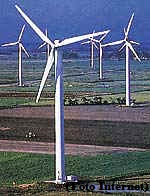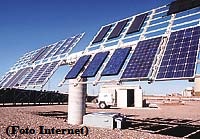

The reproduction of this text is authorised provided that the authorship is preserved and mentioned - copyright: Marcus Martins-PY4SM/PY2DD
This text is being written in the year 2001 and when it comes to ENERGY is always good to remember that we are speaking on the basis of life. Without it would not be possible to exist any form of life. SHE is who gives movement to the things, the waves of the sea, the tides, the wind, etc.; Is who allows us to feel, breathe, love, live; Is who gives us strength for the conducting of our simpler tasks like walking, jumping, running, thinking; Is who gives us strength to develop our various jobs: planting, manufacture, transport, etc.; Is who enables us to feel the life, the feeling and the emotions.
In science, energy (from the Greek έν in, εργον work, work within the work) refers to one of the two physical quantities required to correct description of interrelationship-always mutual-between two loved or physical systems. The second greatness is in the moment. The loved or systems to Exchange interaction energy and time, but do it in a way that both magnitudes always meet is its conservation law.
Is well-pervasive not only in common sense-that energy is usually associated with ability to produce work or perform an action. In fact, the etymology of the word originates from the Greek language, where εργος (ergos) meaning "work". Although not quite comprehensive with respect to the definition of energy, this Association is not shown entirely out of the scientific domain, and, in principle, any entity that is working-for example, to move another object, the deformà it or make it be traversed by an electric current - is to "transform" part of its energy, transferring it to the system on which performs the work.
The concept of energy is one of the essential concepts of the physical. Born in the 19TH century, plays a crucial role not only in this Chair as in all other disciplines which together make up the modern science. Notoriously relevant in chemistry and biology, and even in economics and other social areas, energy stands as cornerstone, since the trade of energy moves billions annually.
In 2001, our country is facing a severe electrical energy crisis ...-the truth is that there is NOT Electrical Energy sufficient for normal consumption-the Electrical Power available must be used/spend wisely. Worth pointing out that this crisis represents a very difficult stage in the history of our country and, without doubt, it will be necessary to all special behavior and a great effort of adaptation to this new and harsh reality. This is a very serious crisis but we have to win it, provided that you, your family and all Brazilians to become an active part of the solution.
In fact, are several important factors that have contributed to the worsening crisis. Much is said about this matter and we always ask if the fault occurs is the "lack of rains or Government investment"? Whatever the culprit for electrical energy crisis that threatens the economy and the peace of the country, some factors are quite evident: all rivers tank plants hydroelectric power stations of Southeast region (region of greater energy consumption in the country) that should be, at least, with 50% of its capacity (to withstand the dry period - autumn and winter), are far below this mark, only 34%.
Other countries make their energy investments seeking to diversify the types of Generating Plants, precisely to minimize or even avoid, supply crises. In Brazil, unlike, concentrated more than 87% of the generation of Electrical Energy in power plants Hydroeletric that depend on the "goodwill of San Pedro". The other, almost 13% are produced by plants hydroelectric power stations beef (around 10%) and Nuclear plant Angra dos Reis (around 3%).
President Fernando Henrique Cardoso, speaking on the subject, stated that "... was blindsided by the necessity of rationing. And make the matter of highlighting Word surprise ... ", repeated the President of the Republic. The National Institute of Meteorology maintains that in the region of Furnas, for example, the index of rainfall (amount of rains) is the lowest of the last 20 years and, already in the month of March, the Institute warned that the rains of April and may would be insufficient to fill the tank rivers Hydroelectric plants © beef located in Southeast regions, Midwest and Northeast. The Minister Pedro Malan (Economics), however, admits that there was no "communication failure" between the various areas of Government in the interpretation and acceptance of predictions, which could at least have decreased from the effects of the electric energy crisis.
The character of investments in the sector energetic has been attributed, by experts, as the main cause of the current crisis. It is worth noting that the production of Energy received per year, an average of $ 13 billions in new investments. In the years 90, this average has fallen to $ 7.6B, while consumption continued to grow 5 percent annually. Assertion made by professor Luiz Pinguelli Rosa, UFRJ, call attention to the fact that even through the crisis, the expense of rationing, holidays and/or blackout, the problem can persist for over three years. The professor said: "the current problem has nothing to do with the reduction of rains. It is not for lack of rainfall this year, but because the tank rivers come being emptied, since the operation is being carried out with lack of equipment needed, "he explained. According to him, the problem will only be resolved in the next few years, insofar as they come into operation the thermical plants provided for in emergency plan of the federal Government.
Another problem, in addition to the above, is the lack of integration between the various power plants; in the southern and Northern regions, there will be water and energy, the tank rivers Hydroelectric plants beef are practically full ...; the plants of the Southeast region is otherwise, we suffer with the "lower supply levels since the epoch in which they were built"; There are rows of high-capacity transmission that would make possible the circulation of energy between these regions ", integrating the country and solving the problem. It must be remembered that due to the high level of the tank rivers North and South plants, these two regions will not need do the rationing that is being adopted in the Southeast, Midwest and Northeast. Experts claim that it was not just the lack of rain that caused the energy crisis tica which the country faces. The fall of government investments in the sector until the Decade of 80 received on average $ 13 billions and that 90 years went on to receive only $ 7 billion, and the predominance of hydroelectric model of generation of energy, are singled out by experts as the source of the crisis that should not last only this year.
The risk of rationing is too high and it will be longer than that is if admitting, says the Director of the National Institute of Energetic efficiency (Inee), Jayme Buarque de Holanda. Even with many projects underway, most of the works should only come into operation after 2,002, year in which probably also there will be crisis in the production of energy. The construction of Thermo electrical plants is singled out as one of the ways to decrease the crisis.
In 99, the Government has launched a program of construction of several power plants, with the support of Petrobras, but the lack of agreement on the price of natural gas and even the missing parts in the international market for the construction of many Thermo electrical plants plants jammed the plans. In addition to Thermo electrical plants, plants, there are several options in the decennial plan of Eletrobras 1,999/2,008, which would cause the generation capacity of the Brazilian energy increase of 68 thousand megawatts to 104.6 billion. The improvement of the binding of several Brazilian regions is also cited as one of the possible solutions, since there is surplus in production of the South, particularly in the Itaipu Hydroelectric, and in the North. According to experts in the energy market, whatever the plan adopted by the Government, including whether he adopts all the options above, the essential is that the actions are taken as soon as possible, otherwise, the Brazil pass is also in 2,002 some or several months in the dark, depending on "the mood of Saint Peter".
A deeper analysis of the energy crisis, we can point out 4 important causes:
2-Increased demand-the Brazil is still growing and developing, and last year registered a growth of 4.5%. However the capacity of generation growth had not proportional. It means saying that Brazil needs and consumes more energy every day, but your generation does not accompany this need at the same pace, causing a substantial risk of missing energy.
3-Dependency of Hidreletricas Plants and transmission lines-As commented, our dependency at power plants hydroelectric power stations is the biggest factor of aggravation of the crisis. In actuality they respond nearly the entirety of the energy produced in the country, and the energy produced in a region can be taken to another through the binding of the transmission lines. Unfortunately, in Brazil, the regions are not properly connected, not allowing the energy to flow through the regions: the North and Northeast are not linked to other regions; in the Southeast and Midwest regions the situation is different, the lack of binding of transmission lines prevents the surplus of generation of energy from the Southern region is made available for its inhabitants.
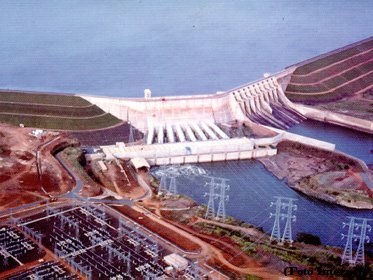
4-Climate-No doubt that the climate is the most important component for generation of Energy for power plants hydroelectric power stations being required a great deal of rain so that the tank can fill rivers and trigger the turbines. Due to the great reduction in investments for typically of Generating Plants, the current hydroelectric power stations in operation are producing the maximum possible and therefore consuming apace "small" reserves of water from your tank. The change in the weather a substantial fall in determining rainfall intensity, dramatically decreasing the volume and speed of spare water reserves in the tank rivers of hydroelectric power stations in operation, clearly demonstrates their dependency to the climate.
-Meet the energy sources and learn about the "pros and cons" of each one of them-
We can say that the human force is the first and most primitive form of energy (produced by human muscles). So the man discovered and used the fire (energy windchill) took his first (obvious) profitability analysis of intelligence, called "Age of fire". Evolving, humans began to use energy from other humans and first began, the era of slavery. Discovers then the energy animals (oxen, cows, horses), creates and develops the mills utilization of wind energy. In a next step, create the steam machine initiating the Industrial age. The automotive (vehicles, furniture, auto steam boats, etc.) generating many new jobs, allowing the consumption, development, comfort. Throughout the history of civilization, man has always sought to discover, understand and develop new ways to produce and store energy, so, through the ages learned to use natural energy sources, such as: solar, wind, nuclear, and pod ³ fan hydraulics. Each one has advantages and disadvantages, and generally a source of Electrical Energy is considered viable when allows producing energy in the amount required to maintain "constant supplies"; when its cost of production is compatible with the benefits it affords; When the risks to the environment are small or non-existent and may be controlled and monitored.
I-wind energy can be achieved with a system of propellers that transforms the force of wind into electricity. Are giant pinwheels installed in prime locations in terms of strong winds, most of the time (the day that there is wind will not be possible for the generation of Electrical Energy). Do not have record of his discovery, but it is estimated that there are thousands of years old. The wind energy is an abundant source of renewable energy, clean and available everywhere. The utilization of this energy source for the generation of electricity on a commercial scale, had beginning there are little more than 30 years and through knowledge of aircraft industry equipment for generation wind evolution ram quickly in terms of ideas and preliminary concepts for high-tech products. One of the great advantages of wind power plant is your download role level of aggression to the environment... because its pollution is only visual, electrical energy is produced by a generator powered by a huge helice who, in turn, is moved by wind speed. Even with current technology, is not yet possible to predict the action of the winds and this can cause failures in generation and supply, causing the Wind Power is not to be considered a "hard" Power, serving as a complementary solution across sites and enabling conditions will stay special, favored by the winds, such as the northeastern Brazil.
Here in Minas Gerais, CEMIG operates an Experimental power plant located in the city of Gouveia and develops research about this important energy source. At the beginning of 70 years, with the advent of the world oil crisis, there was a huge interest of the European countries and the United States to develop equipment capable of producing electricity and that could not go at maximum the dependency of oil and charcoal. more than 50,000 new jobs were filled and created components and equipment industries. At present, the industry of equipment for WIND power plants, metabolic has accumulated annual growth of 30% with movement of approximately $ 2 .6B of annual sales also. In the world there are currently more than 30,000 wind turbines of large enterprises in operation, with an installed generating capacity of approximately 13,500 MW. Through the International Committee of Weather changes, has been studied the deployment of 30,000 MW until the year of 2,030, and such a projection be extended in function of the prospect of selling "Carbon certificates". In Europe, it is great the contribution of Wind Energy; Denmark with 12% of the total Electrical Energy produced; in Northern Germany the contribution of Wind Energy has increased from 16%; and the European Union has set the goal to generate 10% of all electricity until 2,030. In Brazil, where the use of the force of the winds has been done traditionally with the utilization of pinwheels for pumping of water, the measurement of wind carried out recently in all national territory, showed the existence of a huge wind potential Lycus ready to be explored. Northeastern States like Ceara, is targeted for special attention, since it was one of the first places to carry out a program of analysis and survey data of wind potential Lycus through wind measures carried out with modern computerized anemografos. Also in Minas Gerais, for example, a wind plant is already in operation since 1,994, in one location (there is more than 1000 km from the coast) with excellent conditions of wind.
The total installed capacity in Brazil is of approximately 20.3 MW through wind turbines of medium and large companies connected to the electrical network. There are still dozens of wind turbines small business installed and running in isolated places and with varied applications, such as: water pumping, battery charging, telecommunications, rural, rural, etc. Evaluate precisely the wind potential in a region is the first and fundamental step for good use of the wind resource, lico as a source of energy. In General, the wind data collected for other uses (airports, weather information station, agriculture) are little representative of the energy contained in the wind and cannot be used for the determination of the Electrical Energy generated by a wind turbine. The first computerized anemografos and special sensors to analysis of Wind Power were installed in the State of Ceara State and on the island of Fernando de Noronha-Pernambuco just at the beginning of the years 90. The good results obtained with those of favored measurement variance calculation needs the wind potential Lycus of those sites and the installation of wind turbines. Several Brazilian States have followed in the footsteps of Ceara and Pernambuco and initiated their programs wind data collection. Today there are more than a hundred computerized anemografos scattered by several Brazilian States. The analyses of wind data from various locations in the Northeast confirmed the characteristics of "trade winds" that exist in the region: speeds average windy days quite high, little variation in the direction of the wind and little turbulence throughout the year. In addition were observed Weibull form factors (the distribution Weibull statistics), k, greater than 3 (amounts considered too high when compared with the winds recorded in Europe and United States). Given the importance of the optical characterization of WIND resources Catholic Northeast region, the Brazilian Centre of Wind Energy – CBEE, with the support of the National Agency of Electric Energy – ANEEL and the MCT-Ministry of science and technology-has launched, in the year of 1,998, the first version of the wind Atlas Lycus of northeastern Brazil with the objective of developing rich atmospheric models, analyze data and develop winds wind maps reliable Catholics for the region.
II-electrical energy from fossil source fuels is obtained from the burning of decomposed plant material, such as charcoal, oil, natural gas and oil shale. Several power plants generation the charcoal and mineral oil fuel exist in our country. Known as thermo-electric power plants beef or as thermo-electric power plants, are the Favorites in all world, due to its versatility. Are of simple construction and quick, can be installed next to the large consumption centers and dispense transmission lines of long journey. In first world countries, approximately 70% of the electrical energy is produced in plants of this type. The cost of production of the kilowatt is greater than that of a hydroelectric power plant, though much smaller than a nuclear power plant. The major drawback of the termoeletrica plant is the large production of carbonic gas. This gas produces the greenhouse effect that is increasing the average temperature of the Earth. Called thermo-electric beef why are constituted from 2 parts, a thermic where produces a lot of steam at high pressure and other electrical which produces electricity. The process is simple: 1-the Electrical Energy is produced by a generator; 2-the generator has a shaft that is driven by a turbine; 3-the turbine is powered by a jet of Steam under strong pressure after use, the steam is played out in the atmosphere; 4-the steam is produced by a boiler; 5-the boiler is heated with oil burning fuel. The burning of the oil will pollute the environment.
III-Using the heat from the Sun's rays, can produce electrical energy--the energy called solar energy. Although useful and applicable in various situations, the solar energy "is not firm." we still have difficulties to predict (accurately) if we're going to have Sun or rain. Another limiter is not be possible to produce on a large scale since its extensive use would require enormous extensions of land to the distribution of the panels, collectors used to capture and transform the Sun's rays into electrical energy. These enormous extensions of lands occupied by hunter-gatherers could not be used for other purposes-for example, for agriculture, livestock. Although their use on a large scale is not possible, solar energy is in fact an alternative energy policy. In Minas Gerais, Cemig has been using successfully solar energy to meet the rural region, installing collectors in schools, community centers, small farms and remote locations of the electrical network, totaling approximately five thousand properties.
Used the principle in satellite cells of photovoltaics descended to Earth and make daylight turn electricity. The technique of using small wool ¢ mines to capture sunlight and generate electricity was slowly coming out of the laboratory rivers until reaching the application practice today the cheapest way is in watches and solar calculators. Photovoltaics is very different from the thermal solar energy, which already exists until in habitual references where the Sun's heat is used to heat the water. The conversion of light into electricity is made by photovoltaic cells. Solar energy is still more expensive than the oil. To land the Sun is the most abundant source of energy, we can say that virtually all other forms of energy derived from solar energy. Why mankind is making great efforts for doma-there, through various processes such as: 1-solar heating of houses, buildings; 2-solar collectors of mirrors, which can heat the water as in the boilers, to produce electrical energy, solar cells that allow the direct conversion of solar energy into electrical energy, as already exist in phone stations, in isolated places, automatic test furniture, artificial satellite, etc. A typical vehicle to circulate by the congestion of the big cities is the SCV-0, built by a Japanese company. Is an electric car battery-powered, she transforms sunlight into electricity, and can recharge the batteries of the car while he walks. In sunny day its autonomy can reach 160 km, its maximum speed is 65 km/h, suitable for a small car for urban use, and has room for only two people. The Sun emits a broad swath of flat lock radiation including visible light, infra red and ultra violet (UV), which is divided into UVA, UVB and UVC.
Sunlight is the major source of exposure to UV radiation and human affects virtually everyone. The extension of the display of an individual, however, varies widely and depends on the multiplicity of factors such as clothing, long occupation, lifestyle, envelhecimnto and graphics enabling factors such as latitude and altitude. The show was held to UV also increases with the decline of the ozone layer in the stratosphere. Other factors that influence nciam the exhibition to UV include heat, wind, humidity, pollutants, presence of clouds, snow, station of the year and time of day. The consequences of this exhibition are also influenced by factors such as the amount of melanin in the skin. The boards of artificial tanning are made up of a transparent acrylic structure that allows the passage of light generated by a series of lamps. The use of eye protectors is imperative during the sections, because there is a risk of Burns of cornea and code until blindness. The tanning lamps produce UV rays that beyond the darkening of the skin, cause premature aging, wrinkles, loss of elasticity of the skin, damage to the DNA of the skin cells and formation of cataracts.IV-the first nuclear experience was made in 1942, in the United States. The history of Nuclear energy in Brazil begins after the war with the struggle of Admiral Alvaro Alberto against the American connections pressure to reach the property control of the world's reserves of thorium and uranium. Admiral Alvaro Alberto, Brazilian representative, was only to oppose The injustice the proposed in the Baruch Plan. The Admiral described the politics of E.U.A. "attempt to apropriation". In 1951 then President Getulio Vargas of Brazil created the CNPq (Conselho Nacional de Pesquisas) naming, Admiral Alvaro Alberto for the u.s. Presidency. In 1951, the Admiral Alberto proposed a legislation to protect the national reserves of thorium and uranium against the intent of foreign esploracao. In this context the Admiral defended the thesis of region-specific, it was worth saying that no commercial transaction with strategic minerals aspects (term coined by Alberto) should be held against payment in dollars, but on the basis of an exchange of technology. The resistance of Admiral Alberto substances were insufficient to prevent the capture of Brazilian deposits assault by Americans, that already in 1952, they were an only time all have quota that they guaranteed for 2 years.
The inflexibility of the Americans tied by virtue of the "Mcmahon-Act, precluded any cooperation with Brazil. The desired cooperation, however, was an illusion that the American envoy to "liberate" the policy of export of minerals, Gordon Dean, insisted on feeding. As a result, that the Admiral Alberto asked for authorization to the Brazilian Government to enter into negotiations with other countries. In the CNPq mission he travelled to Europe where he would contact in France and Germany occupied by the allies. In France, negotiated the acquisition of a "yellow cake" and in Germany proposed that German scientists in activity is legality, ally Bank provide the Brazil Uranium-enrichment technology rejected by the Americans. At this point the mission from Admiral Alvaro Alberto took aspects of secret mission, to the extent that their actions were ignoring other instances stories decision, as the Security Council and the National Department of Mineral production and the General staff of the Armed forces, therefore, to complete his task, that is, transfer the prototypes of the centrifugal uranium for BrazilHe depended on a secret diplomacy is the Ministry of External relations of Brazil. The Brazilian Embassy in Bonn has recommended to await the establishment of the full sovereignty of West Germany, when then it would be possible to import of centrifuges. Formally the CNPq accepted the recommendation but Alvaro Alberto asked the Getulio Vargas a special authorization to the effect that the Ministry of Foreign relations to support the secret shipment of machines. The centrifuges were learned in Göttingen and Hamburg by Military Security Board, less than 24 hours after this query.
The coup plan against the package was forged by the Atomic Energy Commission of E.U.A (USAEC). Alberto, to contact the President of this Commission, Lewis Strauss, not received this, any hope that the machines learned by the allies were released. On the other hand Straus, ably, will counterattack in an offer of "help" of the US allowed by molds E.U.A politics American nuclear. Alvaro Alberto, once again, repeat the wishes of his Government: enrichment plants, a factory of production of uranium hexafluoride, in addition to research reactors. The rejection of the USAEC did Admiral back of hands empty and the next step was the examination of the CNPq, in March 1955. Soon after his dismissal in August 1955, is signed with the E.U.A the programme of cooperation for the recognition of Uranium resources in Brazil. In mid-1956 is installed a parliamentary Committee survey to investigate the problem of atomic energy in the country, specifically with respect to possible dismissal of Admiral have been motivated by American pressure s explained in 4 secret documents from American diplomacy and the consequent acceptance of u.s. trading conditions with the change of the Brazilian policy on export of strategic minerals. The process currently used is the fissao of helium. Nuclear energy is an energy "firm", but its implementation requires a sophisticated technology, requires large investments and always involves great risks to the environment. The electrical power generated by nuclear plants is based on the fissao (breaks, business area) of helium. The raw materials necessary to this process are the uranium or thorium, two radioactive minerals.
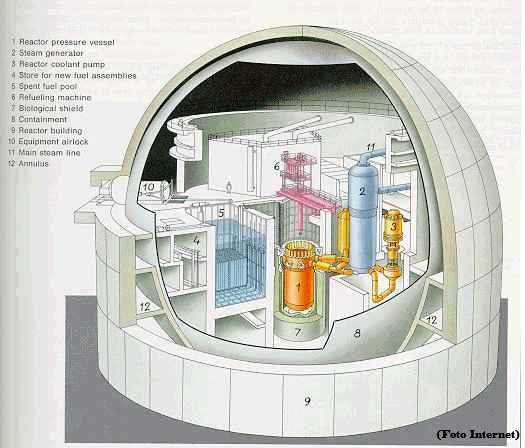 |
|
This nuclear reactor caused fissao of the plant produces huge amounts of heat; This heat, in turn, will be used to heat some amount of water turning it into steam, the pressure of the steam turns a turbine that will trigger a generator; This generator convert mechanical energy from the turbine, in electrical energy. |
Above, a plant of the type built in ANGRA-(RJ) |

V-hydroelectric energy is obtained from the use of the force of the waters. For this, it is necessary to build a dam in a river and accumulate water in large quantities in a reservoir. The water is conducted by a tunnel and turns the turbines, producing electricity. From hence, electricity is transported to stations via transmission lines. Of the stations, the energy reaches consumers through distribution lines. Of all sources of energy, hydroelectric is the most important for Brazil, where almost 100% of all the energy comes from power plants hydroelectric power stations. Unfortunately, approximately 18% of this production ends up being wasted by misuse in the city and in the field. This waste makes it even more serious energy crisis, a situation like this that now affects Brazil. Now that you know a little about the ways of production, can realize the power of Brazil relies heavily on hydroelectric power stations plants. This dependence is one of the causes of the crisis, but there are other factors which you already know.
Hydro-Electric plants are made of 2 parts. A where is the generator and which is in charge of production of electrical energy. Another where the turbine and is moved by water. The production cost of kilowatt is smaller than all other forms of electric energy production. The reason is very simple: the raw materials is the water which falls from grace of heaven. Another great advantage, besides the cost, is that it does not exist any kind of pollution. The world scenario, Brazil occupies a privileged position: is the only country in the world which dominates energy production technology hidro-eletrical and geo-climaticas conditions for round gem-Hydraulic Plants. Maybe that's the reason of so many initiatives from developed countries against the construction of hydraulic power plants in Brazil. Of all electrical energy produced in Brazil, almost 97% is produced in hydraulic plants. Of all forms of energy production, the hidro-eletrical energy is the cleanest, pollutes the air and is ecologically correct. Of all forms of energy production on a LARGE SCALE, the hidro-eletrical is the only totally renevable and that produces no pollution atmospherics. The production process is simple: 1-Electric energy is produced by a generator, in force; 2-the generator has a shaft that is driven by a turbine; 3-the turbine is powered by a jet of water. After use, the water continues its journey down the river; 4-the water is stored in a Reservoir to be used in periods of drought. When the reservoir is full already, the excess water is dumped through the spillway. One of the side effects of the construction of a hidro-eletrical plant is to regularize the Flow of the river. This means that the river has water year-round and in periods of no rain causes floods and basin.
To be provided with water (raw materials of hidro-eletrica plant) even in periods of drought (dry months between May and November), is built a reservoir where the water accumulation in the summer (months with too much water) is stored until the arrival of winter. Waterworks promotes the preservation of fauna and flora. In the months of drought is very common some rivers become dry, completely destroying its fauna and flora. The reservoir provides also the development of fish farming ensuring the survival of fishermen. Finally, the reservoir is a great location for our leisure. Size (capacity) of the reservoir is calculated very carefully (the studies take into account 10,000 years of rains) so that even in periods of great drought the water supply does not reach the minimum. V-hydroelectric energy is obtained from the use of the force of the waters. For this, it is necessary to build a dam in a river and accumulate water in large quantities in a tank River. The water is conducted by a tunnel and turns the turbines, producing electricity. From hence, electricity is transported to subestacoes by means of transmission lines. Of stations, the energy reaches consumers through distribution lines. Of all sources of energy, hydroelectric is the most important for Brazil, where almost 100% of all the energy comes from power plants hydroelectric power stations. Unfortunately, approximately 18% of this production ends up being wasted by misuse in the city and in the field. This waste makes it even more serious a situation of energy crisis, like this that now affects Brazil. Now that you know a little about the ways of production, can realize the power of Brazil relies heavily on hydroelectric power stations plants. This dependence is one of the causes of the crisis, but there are other factors which you already know.
The Furnas Hydroelectric power plant was the first plant built by the company, which inherited the name. The dam is located in the middle course of the Rio Grande, in the stretch known as "Rapids of Furnas", between the cities of São João da Barra and São João Batista do Gloria, in Minas Gerais. Its construction began in July 1958, and the first unit, entered into operation in September 1963 and sixth, last set in project, in July 1965. At the beginning of the Decade of 70, has started its technological for the installation of the seventh and eighth, with a total of 1,216 MW units, which put the work between one of the largest in Latin America. The privileged location of the plant (500 km from Rio de Janeiro, 400 miles of São Paulo and 300 km from Belo Horizonte), has avoided, in the middle of the Decade of 60, a huge collapse in Brazil, avoiding fuel rationing and cutting electrical power supply to the Brazilian industrial park. The expected power at the beginning of its construction corresponded to 1/3 of the total installed in Brazil.
The Hydroelectric power plant of Furnas, in addition to constituting a milestone of installation of large hydroelectric power stations in Brazil, made it possible to regulate the level of water of the Rio Grande and the construction of eight more plants, leveraging entirely a potential of more than 6,000 MW installed. In the area of the power plant of FURNAS, are also important areas of service: hydrobiology and Pisciculture laboratory: works on creation of fish for the restocking of tanks and planned preservation of quality of dammed waters, serving, in addition to the power plant of Furnas, Peixoto, Estreito, Itumbiara, Itutinga, Camargos e Jaquara of Cemig; Electric and Electronic Measurements Laboratory (LAME): provides technical assistance to the activities of maintenance and operation of the electric system of Furnas. LAME is recognized nationally for its especializacao in the field of instruments, medication and testing electric-electronics and physical-chemical. Is accredited by Inmetro and is part of the Brazilian network of Calibration (RBC); Training center of Furnas: is responsible for the formation and progress of hand workmanship specializing in the field of electric-electronics, operation and control of electrical power systems, providing consulting and services to the electric sector companies in Brazil and abroad.
River tank: maximum extension: 220 km/ maximum level of storage: 768/ level of maximum full: 769.30/ minimum level of operation: 750/ flooded area: 1,440 km²/
total Volume: 22.95 .66Bm³/ useful Volume: 17.217 .66Bm ³
(Copyright: Marcus Martins-PY4SM/PY2DD) - The reproduction of this text is authorised provided that the authorship is preserved and mentioned
Query sources and references: CEMIG – Centrais Elétricas de Minas Gerais / Portal Terra / Energia Nuclear - Marios HP / CESP - Centrais Elétricas de São Paulo / ITAIPU - Hidrelétrica
.gif)

